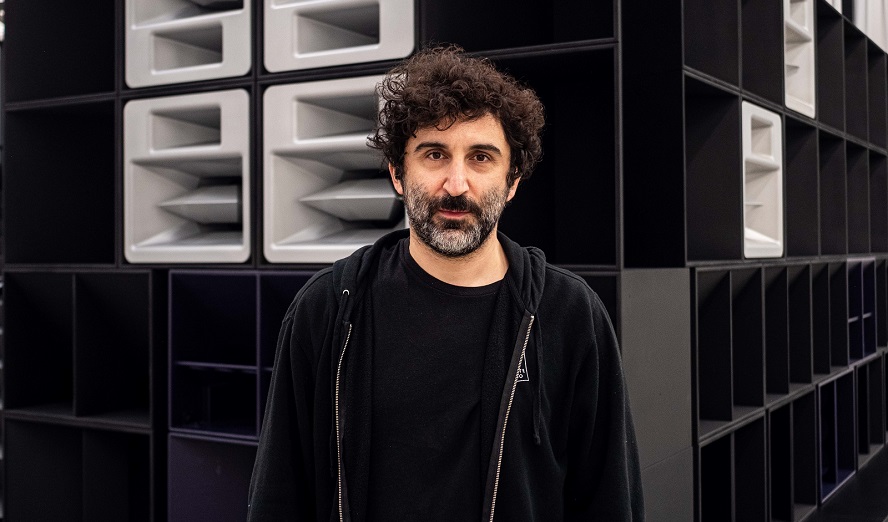After being socialized in Istanbul’s rock scene, becoming an architect and making high-profile art installations, Turkish percussionist Cevdet Erek developed an interest for 19th century fortepianos. Following an invitation by TONSPUR Kunstverein Wien, he created a audio-visual art installation in Vienna. When we talked with Erek about the transcultural history of Classical music, 20th century avantgarde, and folk culture via Zoom, he was wearing a hoodie by thrash metal titans Kreator.
skug: Could you tell us a little about the project you’re doing in Vienna at the TONSPUR_passage and Micro Museum for Sound?
Cevdet Erek: First of all, in these kinds of projects, I never know the final form until a day or so before its release. However, I know quite a lot about what I want to try here. I barely do sound-only stuff. Primarily, I prepare spaces. Mostly temporary, sometimes using architectural means, often sounds, but not always. This project in Vienna is called »A Succession of Turkish Stops«. The title directly comes from a music technology and musicology related subject, which is one of the pedals added to the fortepianos for a specific period. Before the development of the piano as we know it, there were these quasi-pianos with extra pedals. It was in use already by the late 1700s and was especially popular in the first decades of the 19th century. And one of these pedals is called the »Janissary stop«, or the »Turkish stop«. These pedals are triggering or imitating percussive instruments. It sounds like it’s a bass drum, a bell, or a cymbal. Yesterday, I was chatting to Professor Katharina Olivia Brand from Kunstuniversität Graz, who’s also a performer of period instruments. She was saying that in Austria, in a certain period, there was a tendency to meet in interiors, probably because of the political climate intellectuals had to. In this context, the piano was tasked to represent all orchestral music. It had to be richer, louder, with different sounds. Until now, I haven’t seen one of these instruments, which for me is an important part of the project. I’ve been working from a distance. After some search, curator Georg Weckwerth, artistic director of TONSPUR, and I found an original fortepiano from the 1830s with the rare Janisarry stop, built by Conrad Graf, at the University of Music and Performing Arts Graz, and a replica of a Graf fortepiano at the Cologne University of Music (HfMT Köln), made by Paul McNulty, a renowned fortepiano maker based in Czech Republic. I collaborated with a piano student and prospective tonmeister from Köln, Julian Burdenko. Yesterday, we sampled some sounds, hits and patterns as well as Julian’s improvisations, he was with the fortepiano in the studio, and I was here at my place in Istanbul. I already started adding some of the recordings to my drafts. The idea is, you pass through the TONSPUR_passage at Museumsquartier and you hear these samples. Hits. Sounding like drums and cymbals, but hopefully also like explosions from far away. A war scene. Historical or from now. Today we have similar war scenes. Very close to where you are or where I am. Bombs explode a lot. I’ve been trying to make these kinds of connections in some of my work for quite a time. In this project, also with a style of percussive and rhythmic music, called »Turkish music« in the Classical era. It starts out in an army’s band, moves to an »enemy’s« city, in this case Vienna, and becomes a hip thing. Like drum’n’bass or similar electronic dance music of our times.
You started out with saying you want to create a space and…
Always. If I have a chance. My primary training is in architecture, perhaps this is the main reason. Making spatial experiences is a principle, including at any concert. Sorry for interrupting.
So, you want to represent a war scene?
Not really. But to have connections to one, using some basic elements. The sound parts of my works are rather simple. I wouldn’t say minimal, but they usually don’t include that many layers or ornamentation. I want to make a connection to some of the popular music of our times, mostly techno or electronic dance music, which still make use of these bass drum like sounds. Then, of course, noisy aesthetics. Either noise music, contemporary music, or metal. That’s our folk culture.
The use of a piano as a percussion instrument has a famous precedent in the 20th century, namely…
Prepared Piano!
Yeah, prepared piano. From my knowledge, you engaged with its main representative, John Cage, at least twice. And I’ve been wondering if that’s an influence.
I attended many concerts and some recordings in the studio that I worked at as a tonmeister. But I never played a prepared piano piece myself. There is a connection. Strangely, it seems that not many people around me are aware of these »Turkish« or »Janissary pedals«. It’s not only the drum-like sound or the cymbal. There’s also another mechanism that uses parchment paper on bass strings which changes the sound to something resembling the buzzing sound of another instrument, resembling a bassoon. Our project would like to remind or inform some people of these historical instruments. Another practice I would like to allude to are samplers with pads or digital keyboards. Where you imitate or represent sounds of other instruments with tapping on something. The Turkish stop if connected to the music of our times, the 1970s, especially 1980s, 1990s. Or to the modern drum-set culture, to cymbals traveled from Istanbul to Boston, to Jazz or the U.S. Army band.
If I understood you correctly, the project tries to bridge at least three dimensions: a spatial dimension (Istanbul – Vienna), a temporal dimension (classical period – today), and a vertical dimension, between what’s often referred to as a »highbrow culture« and »lowbrow culture«.
Exactly.
Then let’s take the latter as a starting point to ask about your background – in metal music and progressive music and techno. What were formative experiences you had?
For someone like me there were hundreds of influences. Hundreds. I’m not coming from a typical music education. My main thing was interest in music that I heard on the radio, on TV. Then slowly into more alternative scenes. In high school, I was really impressed by Turkish music from the 1970s. Rock in general and what some would call Anatolian pop or rock. Then, there were heavy cultures, especially the heavier size of metal, thrash metal, speed metal. Fastly going to harder versions. Death metal, of course. That was a push to try to learn instruments and make a band, Nekropsi. Firstly, by imitating, then practicing just continuously. When I was attending the MSÜ, the former Fine Arts Academy, we kept on with the band, and slowly went in another direction. First, becoming instrumental and keeping the distortion out. Trying to find an art form, in a way. Then I developed a curiosity for electronic music, sound production in general, started the MA Sound Design and Engineering at İTÜ MIAM, for recording and production techniques, electronic music, there we had also 20th century Western music history and a bit of European classical music theory. But initially the band was kind of a school for us. Then a pause in music, I started doing installations and kept on doing it until now, mostly. It became a very primal expression. On the other hand, we also did our best to keep on with the band, sometimes releasing, playing a few shows a year. It became a hybrid practice, which I’m enjoying mostly and sometimes suffering from. (laughs)
Would you say you keep those strands of practice separate? Are they complementary or is there a tension?
Well, both. There are commonalities and dramatical differences. Tension can be used amazingly in art if that’s your focus. Sometimes you choose to concentrate on tensions, commons, sometimes both.
It seems like you have a very explorative approach.
Hopefully. I’m really enjoying exploring, mostly triggered by personal curiosities. Here, drumming took me to the piano. I had piano classes, but never had a real interest. Now the interest comes from drumming.
The TONSPUR_passage is a transitory space. People walk through. I’m wondering, what significance does the notion of curiosity, which you just applied it to your own work, carry for you regarding the recipient?
Let’s imagine the most hurried person, going to a job or someone who doesn’t have any interest in the work. Are they also our audience? I think, yes. We’re in the public space. We probably have only 5 to 6 seconds to catch someone’s ears or eyes. But still, this is someone who hears or sees. I can provide a short-time soundscape experience. And then, hopefully, some of them stop for a moment, see some images, a detail from a piano, something taken from a war scene, some percussions. I’m hoping that the more curious viewer would investigate more, reading, searching, listening more. In that sense, what we do now is a part of the project, too, a part of the process for those curious. So, this project is not only one stand-alone artwork installed at TONSPUR, but a one-time manifestation of a process.
It’s an honor to be a part of the project, then.
(Smiles) The first thing is, our general audience is someone just passing by. They don’t have to read, don’t have to be educated, don’t even have to read the name of the project. It has to provide a certain aesthetics. We’ll see what kind of reaction we get. It’s not in our control, especially with this kind of approach.
I mean, maybe it doesn’t have to be »in our control«? Architecture and spaces tend to be something that’s not focused on, but something that’s in the background. That is an aesthetic experience as it is lived, bleeding into daily life.
Background is a good term. A scape from far away. I’m not going to be bombarding the space with instruments. I’m not thinking of very loud noises. And you’ll see the loudspeakers. We’re not going to act like if they’re not there. Hopefully, people will be asking: »Why? Why these sounds?« My answers are making rounds, I don’t try to give one singular answer. I hope it makes sense to you.
Usually, when you when you engage with art, you’re presented with a finished product. You get an album, a promo text, and an explanation…
A frozen album.
We get to see an artwork as part of a creative process. This was what you started out with.
I’m glad to be able to communicate. At some point, this project could be turned into a performance piece or another installation. It could include architecture. It could be a recording. It could be a radio piece. This is just one possible demonstration. I would love to bring these ideas to Istanbul, incorporating experiences from Vienna in a kind of discontinuous communication. Who knows what’s going to happen in two months?
Cevdet Erek • »A Succession of Turkish Stops« • TONSPUR 92 • 3:30 min • daily 10–20 h • 16.12.2022–23.02.2023 • TONSPUR_passage / Micro Museum of Sound / MQ Wien
Links:



















